Looking for a beautiful and easy-to-care-for indoor plant? Look no further than the pothos! This versatile houseplant comes in a variety of colors and can be easily grown with just a little bit of light and water.
In this article, we will discuss the different types of pothos plants and how to care for them. We will also provide some tips on how to choose the right pothos for your home. So read on to learn more about these lovely plants!
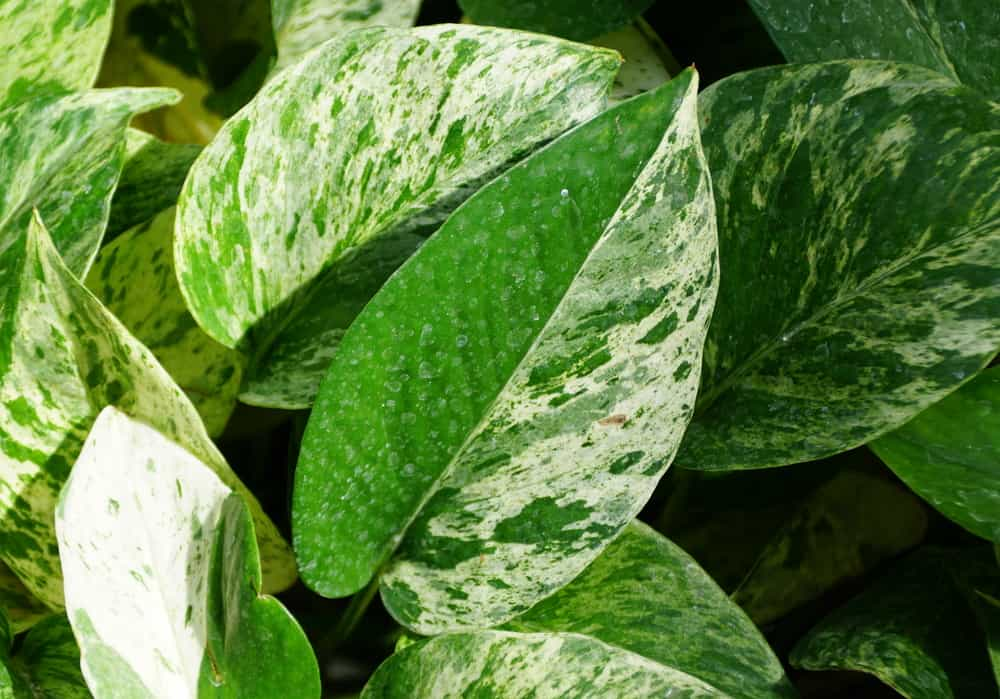
Table of Contents
Best Pothos varieties
Here are 19 different varieties of pothos plants that you can choose from:
1. Marble queen pothos
This variety of pothos has large, glossy leaves with white and green variegation. The Marble Queen pothos looks fairly similar to the golden pothos plant, but it differs with its subtle and different colorations. The leaves are medium-sized and they require a good amount of light to maintain their variegation.
This plant is a great option for those who want an easy-to-care-for plant that can brighten up any room. It is also a good choice for beginners, as it is fairly forgiving if you forget to water it occasionally.
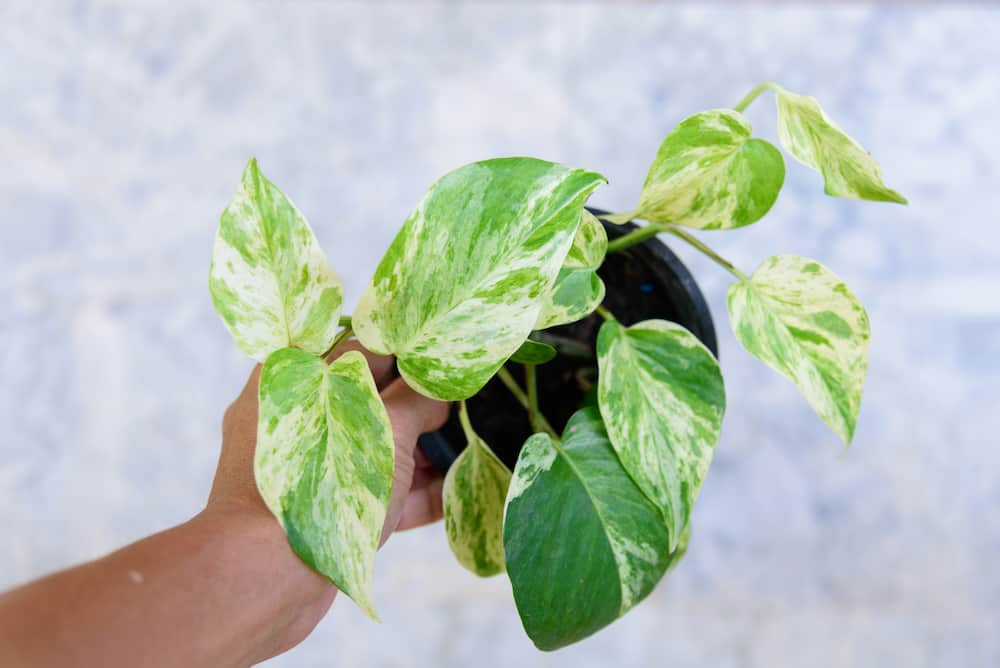
2. Neon pothos
The Neon pothos gets its name from its brightly colored leaves, which radiate a green and yellow hue. Their leaves are very curvy and finish with fine points at the tip, making them very visually attractive and lush looking. This plant is often mistaken for the golden pothos plant, but they are two different varieties.
This plant is a great choice for those who want a brightly colored addition to their home. It adds a pop of brightness in a room of plants that take on deeper and darker green shades.
3. Cebu blue pothos
The Cebu blue pothos gets its name from the Cebu island, which is located in the Philippines. This region is where this plant is endemic. It has very striking, long, and narrow leaves that are a deep blue-green color. It also has a silver-green tinge of color when viewed in the light.
When this plant reaches maturity, it can develop deep fenestrations, which are holes that help the plant to withstand wind and heavy rains on its native Cebu island. This plant is a great choice for those who want an unusual and eye-catching plant for their home and makes a sophisticated vine.
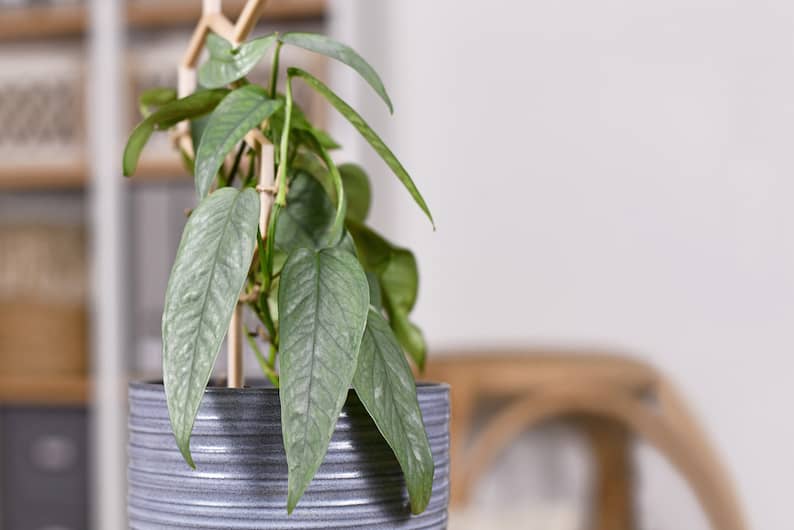
4. Global green pothos
The global green pothos is one of the newer varieties of pothos plants. It has dark green, glossy leaves and is also subtly flecked with medium green hues. The leaf is round and full, hence the term “globe” is used to describe its shape.
This plant is technically considered rare because it’s a newer variation. However, it is gaining popularity quickly and can be found in more and more stores. It’s a great choice for those who want an easy-to-care-for plant that looks great in any setting.
5. N’Joy pothos
This beautiful variation of the pothos plant looks like an abstract painting with its gorgeous matte variegated tones. The variegations do in fact look like brush strokes and contain a variety of colors, including dark green, medium green, cream color, and white.
The leaves themselves are very delicate, thin, and small. This plant works perfectly on an office desk that is next to a sunny window due to its size and need for more light than non-variegated versions of the pothos.
6. Manjula pothos
This is another impressively variegated pothos plant that has deep green leaves with streaks of yellow running through them. The lighter areas of the leaves have dots and flecks of medium and dark green color running through them. The leaves are slightly larger than the N’Joy pothos and have a waxy texture.
The Manjula pothos is very easy to care for and can tolerate low light conditions better than some of the other variegated varieties. However, it will lose some of its variegation if it doesn’t get enough light. This plant is a great option for those who want an attractive and easy-to-care-for plant.
7. Silver Satin pothos
This plant produces beautiful heart-shaped leaves that are larger than many other variations of the pothos. The leaves are a deep green color with silver and white variegations. The variegations can sometimes take on a pink or cream hue as well.
The Silver Satin pothos is one of the bushiest types of pothos plants, especially when placed in bright indirect light and provided with enough water. However, they also make very beautiful and unique vines as well.
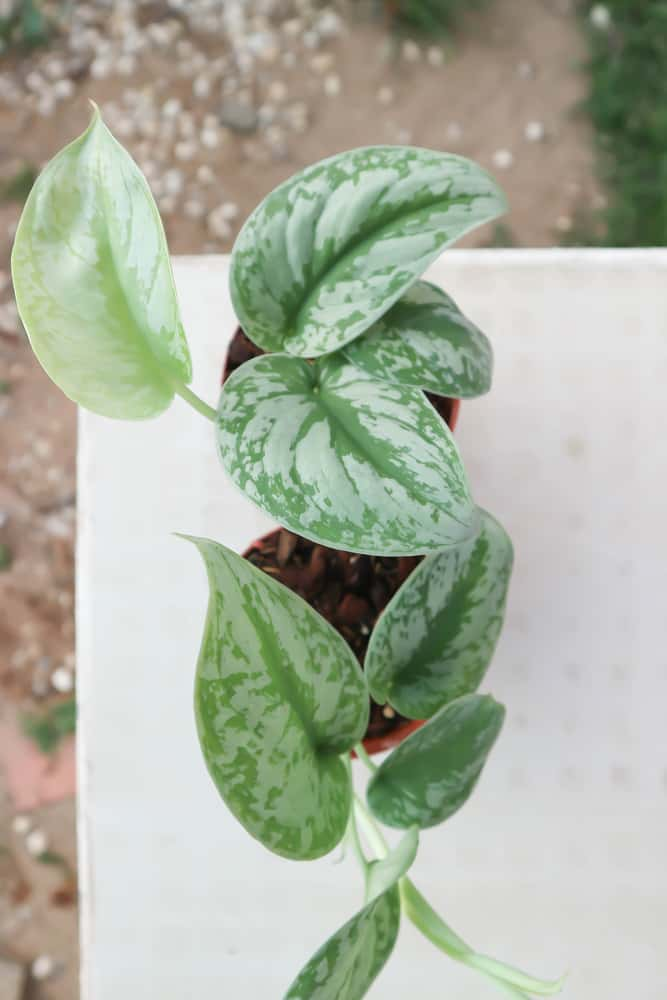
8. Emerald pothos
The Emerald Pothos may appear to be completely green at first glance, but that’s not quite the case as you’ll see once you get up close. Instead, it’s actually variegated with unique patterning that is darker toward the center vein and lighter toward the edges.
While often mistaken for the Global Green pothos, this pothos variety stands apart in its looks, if not its care needs, which are similar to other types of pothos.

9. Harlequin pothos
The Harlequin Pothos is a very rare and hard-to-find variety of the pothos plant. It has large, glossy leaves that are deep green with irregular patches of white variegation. This is often a majority white pothos variety, giving the plant a delicate and ethereal look.
This plant is very difficult to care for and requires very specific conditions in order to thrive. It is best suited for those who are experienced with caring for houseplants and who have the time and patience to provide the plant with everything it needs. It will quickly revert back to all green if it doesn’t receive the proper amount of light, but it’s also important not to burn the leaves.
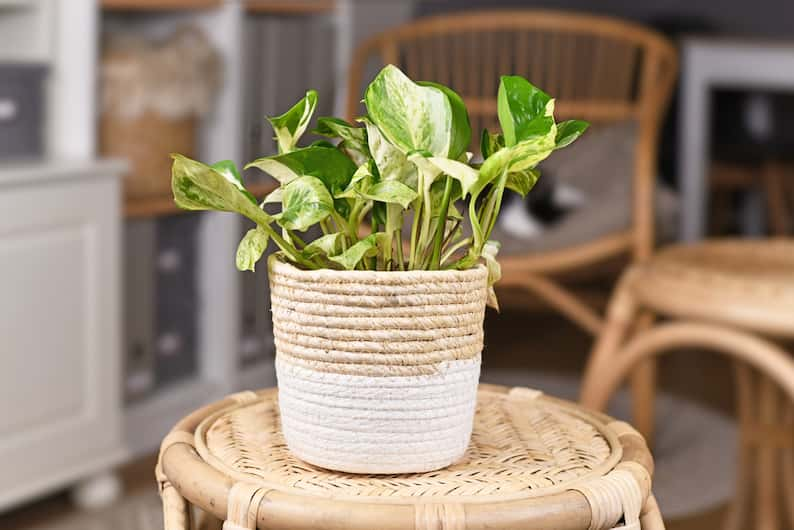
10. Snow Queen Pothos
Plenty of people get confused between the Snow Queen vs Marble Queen Pothos. However, the former has a tremendous amount of cream and white leaves and stems, making it a much lighter and brighter variant.
The green color of the Snow Queen Pothos runs through the plant in thin streaks rather than large patches. This plant is very easy to grow and is a great option for those who want a beautiful and elegant-looking plant. However, it requires a lot of indirect bright light to maintain its perfect balance of cream and green tones.
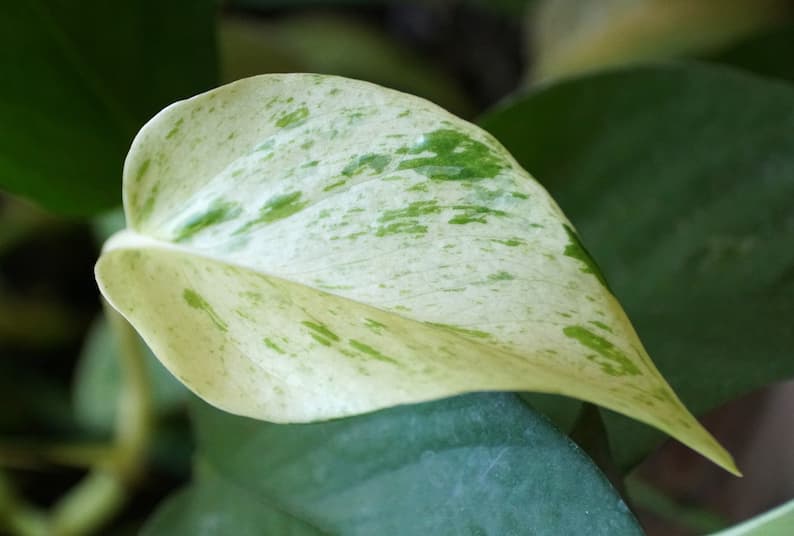
11. Jessenia Pothos
This variety of pothos is an offshoot of the marble queen pothos and was discovered by Costa Farms. It has very similar leaves, but the variegations are much more pronounced. The leaves are deep green with large patches of yellow, making it a more saturated plant overall.
The Jessenia Pothos is ideal for low-light situations, so it can live in your bathroom, bedroom, or any other room that doesn’t get a lot of bright light. However, it will lose some of its variegation if it’s placed in too low of light conditions over time.

12. Satin Pothos
The satin pothos isn’t technically in the same genus as other pothos plants on this list. It is in the Argyraeus genus instead of the Epiperemnum genius. However, it looks so similar to the pothos and has such similar care, that it is often labeled as a pothos plant.
This plant produces small leaves with a very glossy texture. They are deep green with yellow, white, or cream variegations running through them. This plant is very hardy and can do well in all areas of the home. It works best on kitchen window sills or on office desks because of its conveniently small size.
Related: 8 Simple Steps to Propagate Satin Pothos Successfully
13. Glacier Pothos
The glacier pothos is a very striking plant that has leaves that are green with white variegations. The variegations on this plant are very random and can appear as dots, streaks, or even large swirls. This plant is one of the more difficult to care for on this list because it requires very specific conditions.
It is also a rarer variety, so it can be difficult to find. If you are able to find one, make sure that you have the time and patience to provide it with everything it needs. It is best suited for those who are experienced with caring for houseplants and who have the time to give it the attention it requires.
14. Pearls and Jade Pothos
This plant was developed by the University of Florida. It has small and somewhat thin leaves that are outlined by a beautiful white or cream color on each leaf’s edge. There are sometimes flecks of medium green in the leaves as well.
The center of the leaves are usually a medium to dark green, which allows these pathos plants to convert plenty of sunlight into food for the plant. It can do well in both high and low light conditions but is a slower grower either way, so it does well in areas where it won’t be disturbed.
15. Baltic Blue Pothos
This is one of the darkest pothos varieties on this list. The leaves of this plant are deep green with blue or navy undertones, adding a depth of color to the plant. Its leaves are very narrow and sharp, yet are larger than smaller varieties of the pothos plant.
This pothos also develops fenestrations and reaches maturity earlier than other plants, so you can expect it to have large leaves relatively quickly. It can do well in all light conditions but will develop more blue tones in brighter light.
16. Hawaiian pothos
The Hawaiian Pothos is one of the rarer pothos varieties, so definitely snap this up if you see one at your local gardening center. Its green and gold leaves can really make a statement, especially once you see the size of them.
That is, the leaves of this type of pothos dwarf those of other members of the family, meaning this is a large pothos and could be a great choice of plant if you love pothos but want something a bit more striking.
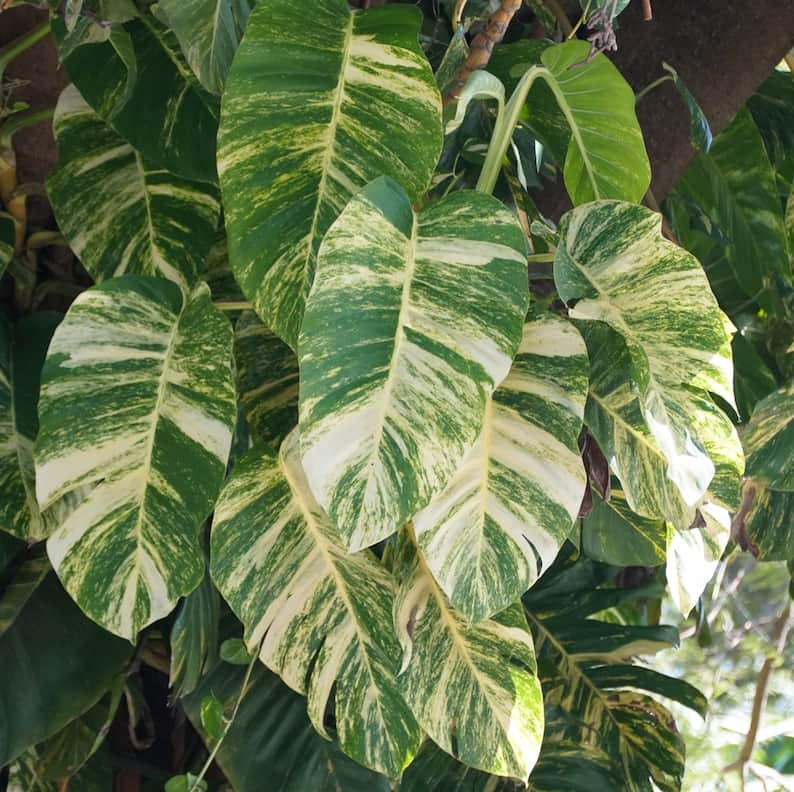
17. Jade Pothos
The popular and attractive jade pothos plant is one of the most common varieties of pothos. It is easily recognizable because of its solid jade green leaves that have a beautiful sheen to them. They are waxy and heart-shaped but aren’t as round as some other pothos varieties.
The jade pothos is also one of the easier varieties to care for, so it is a great plant for those who are new to caring for houseplants.
18. Golden Pothos
The golden pothos is one of the most popular houseplants and for good reason. It is very easy to care for and can do well in all parts of the home. It is also a very versatile plant that can be used in a number of different ways.
This plant has heart-shaped leaves that are green with yellow variegations. The variegations can be in the form of streaks, dots, or even large patches. This plant can do well in all light conditions but will develop more yellow tones in brighter light.
19. Half Moon Pothos
The half moon pothos is a very unique plant that has leaves that are half cream or white and half green. The variegations on this plant are very random and can appear as dots, streaks, or even large swirls.
Many different species of the pothos plant can produce half moon leaves, and the only way to produce more of them is by propagating the plant. This can be done by taking stem cuttings and growing them in water or soil.
What is the rarest type of pothos?
The rarest type of pothos is the harlequin pothos. These plants have variegated leaves that are green, white, and yellow. They can be very difficult to find and care for, particularly with respect to their light needs, so they are best suited for experienced plant caretakers.
However, as they gain popularity, it is possible that they can become more available in stores, nurseries, and gardener buying, selling, and trading groups.
The price of this plant can also be quite high, so be sure to do your research before purchasing one.
What is the most common type of pothos?
One of the most popular types of pothos is the jade pothos. These plants are easily recognizable because of their solid jade green leaves that have a beautiful waxy sheen to them. One reason for their popularity is that they are very easy to care for.
This makes them a great plant for those who are new to caring for houseplants.
Another reason is that they are very versatile plants that can be used in a number of different ways. They can be hung from baskets or trellises, or allowed to cascade over the edge of a pot or container.
Since jade pothos aren’t variegated, plant parents don’t have to worry about the leaves reverting back to an all-green state. It’s truly the easiest pothos to take care of and is a great plant for those who are looking for a low-maintenance option.
How do I know what kind of pothos I have?
In order to identify your pothos plant, you will need to look at the leaves. Each variety of pothos has different shaped leaves with different variegations. The most common varieties are the jade pothos, golden pothos, and marble queen pothos. However, there are many other less common varieties that have more unique leaf shapes and colors.
If you are still having trouble identifying your pothos, you can always take a picture of the plant and show it to a local nursery or gardening center. They should be able to help you identify the plant and give you care tips specific to that variety. There are also several apps as well as Google image search that can help you figure it out on your own.
Some varieties look very similar, so talking to an expert will be your best bet in correctly identifying your plant.
Luckily, if you can’t figure out what kind of pothos you have, they are all generally easy to care for and will do well in a variety of different environments. So even if you can’t figure out the exact variety, you can still provide your plant with the care it needs to thrive.
How do I care for different Pothos varieties?
In general, pothos plants are cared for in very similar ways, save a few tricky variations. Here are some factors to keep in mind that will keep your plant happy and healthy:
1. Provide medium to bright light
Pothos plants can tolerate lower light conditions, but will not thrive in darkness in the long-term. If you want your plant to produce more leaves, provide brighter indirect light.
You can find the brighter rooms in your home, which tend to align with the direction your windows face. You can also supplement with grow lights if you want to provide your plant with even more light.
2. Avoid direct sunlight
Just be sure not to place your plant in direct sunlight, as this can scorch the leaves. In order to avoid this, make sure your plant is at least a few feet away from any windows.
If you notice the leaves of your plant start to turn yellow and brown, this is a sign that it’s getting too much light. Move it to a location with lower light and give it a little break from the sun. You can also place a sheer curtain over any windows to diffuse the light coming in.
3. Water your pothos regularly
Pothos plants live in rainforests in the wild, so they are used to consistent and regular water. Give them water every one to two weeks, depending on the season and the humidity level of your home.
Diffusing the light can help prevent the water from evaporating and will help your plant stay hydrated. In the winter, you can reduce watering to every three weeks or so, as the plant will be dormant and won’t need as much water. Just be sure not to let the soil dry out completely, as this can damage the roots.
4. Don’t overwater your pothos plant
Even though these plants like to be regularly watered, it’s important not to overwater them. This can cause the roots to rot, which will eventually kill the plant.
To avoid this, make sure the soil is dry to the touch before you water your plant again. You can also stick your finger an inch or two into the soil to check if it
5. Make sure you have well-draining soil
Pothos plants also need well-draining soil in order to prevent root rot. This means that your soil should have a mix of organic matter and perlite or sand and maybe even a few rocks at the bottom. If it’s always soggy and never dries out, you probably need to add more of these materials to your soil.
You can also make your own well-draining soil by mixing two parts potting mix with one part perlite or sand. Just be sure to avoid using beach sand, as this can contain salt that will damage your plant.
6. Make sure your pothos pot has drainage holes
Another way to prevent root rot is to make sure your pot has drainage holes at the bottom. This will allow any excess water to drain out, instead of sitting in the soil and causing the roots to rot.
If there aren’t any drainage holes in your pot, you will either have to transplant your pothos or drill or hammer some holes into the bottom of the pot.
7. Check your plant for pests
Pests are always a possibility with any plant, but pothos plants are especially susceptible to mealybugs and spider mites. These pests can cause the leaves of your plant to turn yellow and brown and can eventually kill the plant if they’re not removed.
If you notice any pests on your plant, you can remove them by hand or with a cotton swab dipped in rubbing alcohol. You can also use a pesticide, but be sure to follow the directions on the label carefully. A natural pesticide made of neem and water is a good DIY organic option.
8. Prune your pothos plant regularly
Pothos plants need to be pruned regularly in order to stay healthy and prevent them from getting too leggy. You can prune them by cutting off any unhealthy or yellowing leaves during the growing season.
It’s important that you cut the leaves above the node so that the node will produce new growth. New growth will help your plant to stay full and prevent it from getting too leggy.
9. Occasional fertilize your pothos
If you want your pothos to grow quickly, you can fertilize it during the growing season. You can use a liquid or water-soluble fertilizer and apply it according to the directions on the label. A general houseplant fertilizer will do just fine for the pothos.
You can fertilize your pothos approximately every 2 months, but stop fertilizing the plant when it’s in dormancy, which is during the late fall, winter, and early springtime. Excessive fertilizer during this time will lead to a buildup of salts in the soil that can damage your plant.
10. Repot your pothos every few years
Pothos plants need to be repotted every few years in order to stay healthy. This is because they will eventually outgrow their pot and need more space. If they are left in a pot for too long they will become rootbound which can lead to poor uptake of nutrients and water.
When you do repot your pothos plant, make sure you use a pot that’s only one to 2 inches larger than the previous one. This will help to prevent root rot and pest issues. Repotting your plant also allows you to add fresh soil, which contains nutrients that your plant needs.
11. Keep an eye on temperature and humidity
Pothos plants prefer a temperature range of 60-85 degrees Fahrenheit and a humidity level of 40-50%. If the temperature or humidity gets too high or low, it can cause the leaves of your pothos to turn brown and drop off.
You can raise the humidity around your pothos plant by misting it regularly or setting it on a pebble tray. A pebble tray is a tray filled with gravel or rocks and water. The water will evaporate and raise the humidity around the plant. You can also use a humidifier to raise the humidity in the room, but be sure to keep it away from the plant so that the leaves don’t get too wet and start to rot.
12. Propagate your pothos plant
Propagating your pothos plant is a great way to get new plants for free. All you need to do is take a cutting from an existing plant and grow it in water or soil.
To take a pothos cutting, cut a piece of stem that’s about four to six inches long and has at least two leaves on it. Cut just below a node, which is where the leaves are attached to the stem. You can then place the cutting in a glass of water or pot of soil and wait for it to root.
